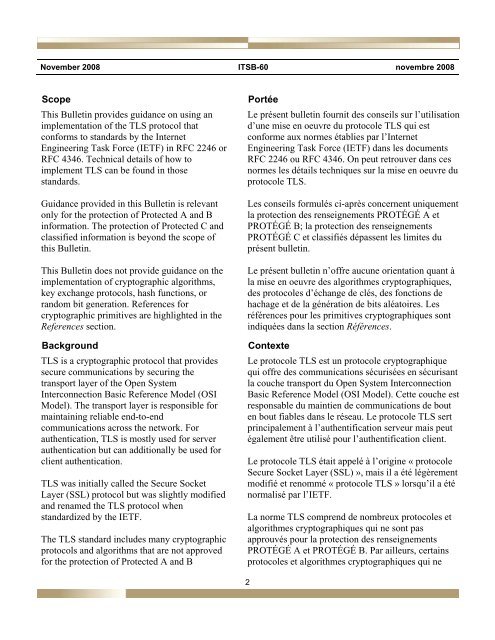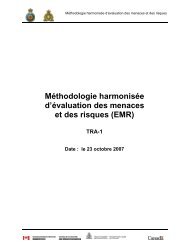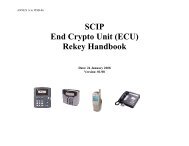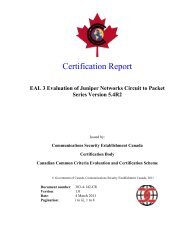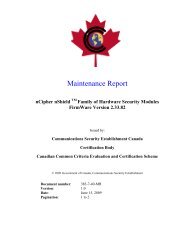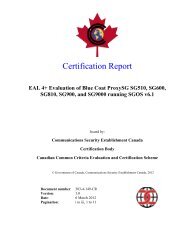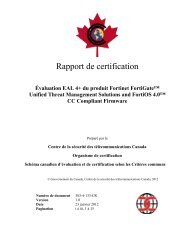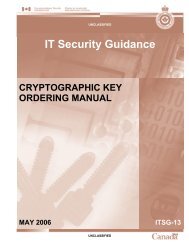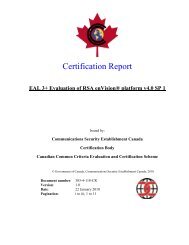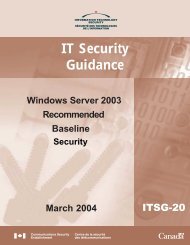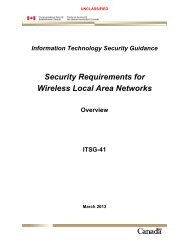Conseils sur l'utilisation du protocole TLS - Centre de la sécurité des ...
Conseils sur l'utilisation du protocole TLS - Centre de la sécurité des ...
Conseils sur l'utilisation du protocole TLS - Centre de la sécurité des ...
You also want an ePaper? Increase the reach of your titles
YUMPU automatically turns print PDFs into web optimized ePapers that Google loves.
November 2008 ITSB-60 novembre 2008<br />
Scope<br />
This Bulletin provi<strong>de</strong>s guidance on using an<br />
implementation of the <strong>TLS</strong> protocol that<br />
conforms to standards by the Internet<br />
Engineering Task Force (IETF) in RFC 2246 or<br />
RFC 4346. Technical <strong>de</strong>tails of how to<br />
implement <strong>TLS</strong> can be found in those<br />
standards.<br />
Guidance provi<strong>de</strong>d in this Bulletin is relevant<br />
only for the protection of Protected A and B<br />
information. The protection of Protected C and<br />
c<strong>la</strong>ssified information is beyond the scope of<br />
this Bulletin.<br />
This Bulletin does not provi<strong>de</strong> guidance on the<br />
implementation of cryptographic algorithms,<br />
key exchange protocols, hash functions, or<br />
random bit generation. References for<br />
cryptographic primitives are highlighted in the<br />
References section.<br />
Background<br />
<strong>TLS</strong> is a cryptographic protocol that provi<strong>de</strong>s<br />
secure communications by securing the<br />
transport <strong>la</strong>yer of the Open System<br />
Interconnection Basic Reference Mo<strong>de</strong>l (OSI<br />
Mo<strong>de</strong>l). The transport <strong>la</strong>yer is responsible for<br />
maintaining reliable end-to-end<br />
communications across the network. For<br />
authentication, <strong>TLS</strong> is mostly used for server<br />
authentication but can additionally be used for<br />
client authentication.<br />
<strong>TLS</strong> was initially called the Secure Socket<br />
Layer (SSL) protocol but was slightly modified<br />
and renamed the <strong>TLS</strong> protocol when<br />
standardized by the IETF.<br />
The <strong>TLS</strong> standard inclu<strong>de</strong>s many cryptographic<br />
protocols and algorithms that are not approved<br />
for the protection of Protected A and B<br />
Portée<br />
Le présent bulletin fournit <strong>de</strong>s conseils <strong>sur</strong> l’utilisation<br />
d’une mise en oeuvre <strong>du</strong> <strong>protocole</strong> <strong>TLS</strong> qui est<br />
conforme aux normes établies par l’Internet<br />
Engineering Task Force (IETF) dans les documents<br />
RFC 2246 ou RFC 4346. On peut retrouver dans ces<br />
normes les détails techniques <strong>sur</strong> <strong>la</strong> mise en oeuvre <strong>du</strong><br />
<strong>protocole</strong> <strong>TLS</strong>.<br />
Les conseils formulés ci-après concernent uniquement<br />
<strong>la</strong> protection <strong>de</strong>s renseignements PROTÉGÉ A et<br />
PROTÉGÉ B; <strong>la</strong> protection <strong>de</strong>s renseignements<br />
PROTÉGÉ C et c<strong>la</strong>ssifiés dépassent les limites <strong>du</strong><br />
présent bulletin.<br />
Le présent bulletin n’offre aucune orientation quant à<br />
<strong>la</strong> mise en oeuvre <strong>de</strong>s algorithmes cryptographiques,<br />
<strong>de</strong>s <strong>protocole</strong>s d’échange <strong>de</strong> clés, <strong>de</strong>s fonctions <strong>de</strong><br />
hachage et <strong>de</strong> <strong>la</strong> génération <strong>de</strong> bits aléatoires. Les<br />
références pour les primitives cryptographiques sont<br />
indiquées dans <strong>la</strong> section Références.<br />
Contexte<br />
Le <strong>protocole</strong> <strong>TLS</strong> est un <strong>protocole</strong> cryptographique<br />
qui offre <strong>de</strong>s communications sécurisées en sécurisant<br />
<strong>la</strong> couche transport <strong>du</strong> Open System Interconnection<br />
Basic Reference Mo<strong>de</strong>l (OSI Mo<strong>de</strong>l). Cette couche est<br />
responsable <strong>du</strong> maintien <strong>de</strong> communications <strong>de</strong> bout<br />
en bout fiables dans le réseau. Le <strong>protocole</strong> <strong>TLS</strong> sert<br />
principalement à l’authentification serveur mais peut<br />
également être utilisé pour l’authentification client.<br />
Le <strong>protocole</strong> <strong>TLS</strong> était appelé à l’origine « <strong>protocole</strong><br />
Secure Socket Layer (SSL) », mais il a été légèrement<br />
modifié et renommé « <strong>protocole</strong> <strong>TLS</strong> » lorsqu’il a été<br />
normalisé par l’IETF.<br />
La norme <strong>TLS</strong> comprend <strong>de</strong> nombreux <strong>protocole</strong>s et<br />
algorithmes cryptographiques qui ne sont pas<br />
approuvés pour <strong>la</strong> protection <strong>de</strong>s renseignements<br />
PROTÉGÉ A et PROTÉGÉ B. Par ailleurs, certains<br />
<strong>protocole</strong>s et algorithmes cryptographiques qui ne<br />
2


